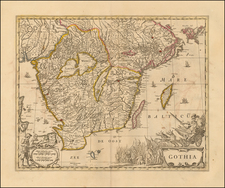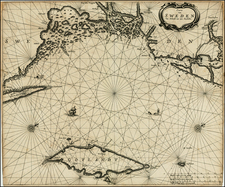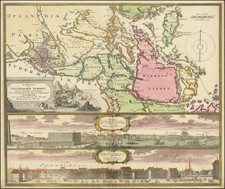Finely executed map illustrating the Siege of Stralsund by the Allied Danish, Prussian, and Saxon Armies in the Year 1715.
The map includes an extensive key, describing details the important places and events of the Siege.
The Siege of Stralsund, an important event in the Great Northern War, unfolded over several months in 1715, marking the decline of Swedish dominance in the Baltic region. Stralsund, a fortified coastal town in Swedish Pomerania, now part of modern-day Germany, was a critical stronghold for Sweden, under the reign of King Charles XII.
Following the Swedish defeat at the Battle of Poltava in 1709 by Peter the Great's Russian forces, the allied powers of Denmark-Norway, led by King Frederick IV, Prussia, under King Frederick William I, and Saxony, saw an opportunity to challenge Swedish control. The English and Dutch navies provided additional support to this coalition, aiming to disrupt Swedish naval routes and fortifications.
The siege initiated in July 1715 when allied forces surrounded Stralsund, intending to sever the Swedish Empire's territorial reach. Despite the strategic importance of Stralsund and its advanced defensive structures, the city's garrison, led by Swedish military commanders including Major General Carl Gustaf Dücker and Admiral Hans Wachtmeister, faced a relentless assault from the combined besieging forces.
The allied bombardment and blockade strategy aimed to deplete the city’s resources and morale. By December 1715, after enduring months of siege warfare, the dire situation within Stralsund forced Swedish commanders to contemplate surrender. The depletion of food, ammunition, and essential supplies had taken a significant toll on the city's defenders.
Negotiations for surrender began as the city's defenses became unsustainable. On December 24, 1715, Stralsund officially capitulated to the allied forces. This marked a significant shift in the control of the Baltic region, effectively reducing Swedish territorial claims and influence in the area.
The fall of Stralsund to the allied Danish, Prussian, and Saxon forces represented a critical juncture in the Great Northern War, highlighting the diminishing power of the Swedish Empire and the rise of Prussia as a key player in Northern European politics. The siege is remembered as a significant military engagement that contributed to the realignment of power in the region during the early 18th century.













![[Sweden] Gothia Auctore Andrea Bareo Sueco](https://storage.googleapis.com/raremaps/img/small/0209ops.jpg)
![[Finland] Postkarte von Finnland und Norrland / Tabula qua Curus Veredarii Per Pinnoniame et Norrlandiam](https://storage.googleapis.com/raremaps/img/small/57036.jpg)